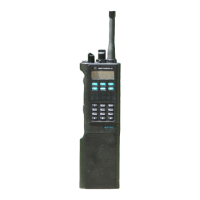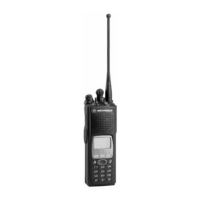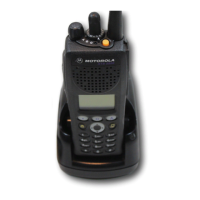-
Transmitter The transmitter consists of three major sections:
• Harmonic Filter
• RF Power Amplifier Module
• ALC Circuits
Harmonic Filter RF from the power amplifier (PA) module (U105) is routed through the
coupler (U104), passed through the transmit antenna switch (CR108),
and applied to a harmonic filtering network in UHF. In the case of a
VHF transceiver board, RF from the PA module (U105) is routed also
through the coupler (U104), then through the harmonic filtering
network, and on to the antenna switch (CR108). The harmonic
filtering circuit is comprised of the following components: L126, L127,
L128, C149, C150, and C151 (for VHF models); or L126, L127, L128,
C149, C150, and C151 (for UHF models). Resistor R128 (UHF) or R117
(VHF) provides a current limited 5V to J2 for mobile ASTRO vehicular
adapter (AVA) applications.
RF Power Amplifier
Module
The RF power amplifier module (U105) is a wide-band multi-stage
amplifier (3 stages for the VHF models and 4 stages for the UHF
models). Nominal input and output impedance of U105 is 50 ohms.
The dc bias for U105 is on pins 2, 4, 5. In the transmit mode, the
voltage on U105 pins 2 and 4 (close to the B+ level) is obtained via
switching transistor Q101. Transistor Q101 receives its control base
signal as follows:
• the microcomputer keys the D/A IC to produce a ready signal at
U102 pin 3
• the ready signal at U102 pin 3 is applied to the TX ALC IC at U101
pin 14 (5V)
• the synthesizer sends a LOC signal to the TX ALC IC (U204 pin 40
to U101 pin 16)
When the LOC signal and the ready signal are both received, the TX
ALC IC (pin 13) sends a control signal to turn on transistor Q101.
ALC Circuits Coupler module U104 samples the forward power and the reverse
power of the PA output voltage. Reverse power is present when there
is other than 50 ohms impedance at the antenna port. Sampling is
achieved by coupling some of the forward and/or reverse power, and
apply it to CR102(VHF) or CR101(UHF) and CR103 for rectification
and summing. The resultant dc signal is then applied to the TX ALC
IC (U101 pin 2) as RFDET to be used as an RF strength indicator.
The transmit ALC circuit, built around U101, is the heart of the power
control loop. Circuits in the TX ALC module compare the signals at
U101 pins 2 and 7. The resultant signal, C BIAS, at U101 pin 4 is
applied to the base of transistor Q110. In response to the base drive,
transistor Q110 varies the dc control voltages applied to the RF PA at
U105 pin 3, thus controlling the RF power of module (U105).
Thermistor RT101 senses the temperature of the TX ALC IC. If an
abnormal operating condition exists, which causes the PA slab
temperature to rise to an unacceptable level, the thermistor forces the
ALC to reduce the set power.

